Forex Day Trading Explained
So, you have probably watched the movie ‘The Wolf of Wall Street’, and maybe even ‘The Big Short’. You think you have a fairly good idea what the typical day trader’s life is like: insane work hours, loads of money, lots of complicated charts (which probably involves some amount of guessing, to read them) and the amount of stress that would even give a whale a heart attack. While there is some element of truth to these assumptions, they are the rare exception. We are here to help ease your fears. Unlike what is the common perception, the average day trader leads a fairly boring life in comparison to men like Jordan Belfort, whose real life exploits were made famous by the movie, The Wolf of Wall Street.
In fact, the average day trader is usually someone who has the normal 9-5 job at a financial institution, usually a bank or a hedge fund. He is payed a good salary and given a bonus at the end of the year based on his performance. This is like most other jobs in the business sector. The typical day trader, however, is usually someone who trades stocks, bonds and other securities. But, there is another type of day trader, the Forex day trader.
The typical Forex day trader does not work at a 9-5 job, trading at a bank or hedge fund. He is usually a retail trader, trading his own money, in his own free time. He usually trades in his own home, and if he is one of the very lucky few, this is the only job that he has. If he has average luck, then he most likely has a typical 9-5 job and trades when he is not working.
So, what is Forex day trading?
Day trading Forex is a little different from day trading other financial instruments. If you trade securities like stocks then you have set hours where you can operate in the market. The New York Stock Exchange is open from the hours of 9:30 to 4:00, and is the largest stock exchange traded worldwide. All the other major stock exchanges open and close around the same hours. In Forex day trading the market is opened 24 hours everyday except on weekends where most major banks and brokers are closed. This means that if you are going to day trade forex, then you have access to all the major currency market sessions, and therefore have a whole period of 24 hours to take advantage of price opportunities in each market. This is very convenient because it means that a typical person can set his own trading hours. This means that if you have any free time at all in the day, then you can day trade Forex.
Trading stocks is also different in the amount of fundamental information that you need to have. With stocks, traders keep track of hundreds of different stocks, the performance of their companies and any news that would affect the value of these stocks in the future. It is a lot to keep track of for any one person, that is why, it is common to have ‘trading floors’ in larger financial institutions that trade stocks. In its simplest form, to learn forex day trading, all a person needs to do is to keep track of price action (learn its signs and signals) and to watch out for fundamental news that can affect the volatility in the market.
As you are probably aware of, in Forex, there are three main divisions for traders. There are short term, medium term and long term forex traders. Day forex trading falls somewhere on the end of the short term division. It is different from scalping, (the shortest form of trading) in that, for the most part, day traders usually only make a few trades (or even one trade) for the day and close them at the day’s end. They do not hold their trades until the next day.
This makes a number of things possible:
Potential for Greater Profits
Unlike the swing trader who looks for position set-ups that sometimes take days or weeks to form, and then even longer sometimes to follow through, the forex day trader has the chance to make multiple trading positions in one day. He has the chance to take advantage of news events and the volatility that occurs in the start of a new market session open or close. He even has the opportunity to trade currency pairs that get stronger when different market sessions cross. (For example many successful Forex traders make their positions at the cross of the Europe and New York sessions).
Kills Boredom
One of the draws that drives people to choose day trading Forex over swing trading, is the excitement of watching price movements during the day. Let us be real, sometimes being a swing trader can be a little boring, especially when you have to wait weeks sometimes for a good trade setup. Many day traders enjoy the challenge of deciphering trade opportunities in a much shorter time frame. Some of them are even self-confessed adrenaline junkies that like the rush that this type of trading provides.
Opportunity to Become Self Employed
Unlike swing traders, who usually have a day job and trade simply as a second means of income, many who become proficient at day trading usually make it their main job. The lure of this is not only becoming your own boss, and not having to answer to a corporation, but also the tax benefits that a self-employed person can claim. People who are self-employed can claim for expenses when filing their taxes. Being a self-employed day trader also means being independent, making your own hours, and having a flexible schedule. It also means taking breaks whenever you want to, unlike in a normal corporate job.
Another reason to learn Forex day trading is that you do not need a formal education at an institution to become a Forex day trader. This is very different to many other career options in the finance sector that require you to gain an expensive education, usually a college degree, in order to find a job. With the amount of information available on the internet, it is becoming commonplace for many traders to teach themselves how to day trade forex.
Where to Start: Forex Day Trading for Beginners
Now, some people will tell you that the first place that a beginner needs to start after learning the basics (term definitions and how the market works) is to figure out the best forex strategy. We agree somewhat with this advice, but we believe there should one more step before that. The first thing that a beginner should learn is to identify what type of trading would suit his particular characteristics.
You should consider day trading Forex, if the following describes you:
- You have time to analyze the market at the beginning of the day, and can monitor your active trades throughout the day
- You would like the security of ending your trade at the end of each day
- You like the idea of short term trading but not the high paced action of scalping
- You have a job that won’t prevent you from looking at price charts during the day, if you have active trades
If you relate well to these, then congratulations, you probably have the makings to become a Forex day trader! Now that you’ve identified that day trading would suit your characteristics, the next step that we need to take is to identify the strategy that you will use.
Day Trading Strategies
Now, this is essentially the basic guide to profitable forex day trading. To learn forex day trading, you need to understand the three basic strategies that day traders use.
- Trading the trend
- Counter-trading the trend
- Break out trading
Trading the Trend
When a Forex trader, trades the trend, the first thing that he must do is to identify the trend. For this, it is especially helpful if a trader uses the longer time frames to identify the main trend that the currency pair is following. For example, if you are a day trader using the 15 minute and 30 minute charts to trade the GBP/USD pair, then it would be wise for you to use the 1 hour, 4H or Daily chart to determine the trend before you make any trading decisions. After you have determined the overall trend (if there are any), then you go back to your shorter time frame. You will use them to better determine the best timing for your trade entries.
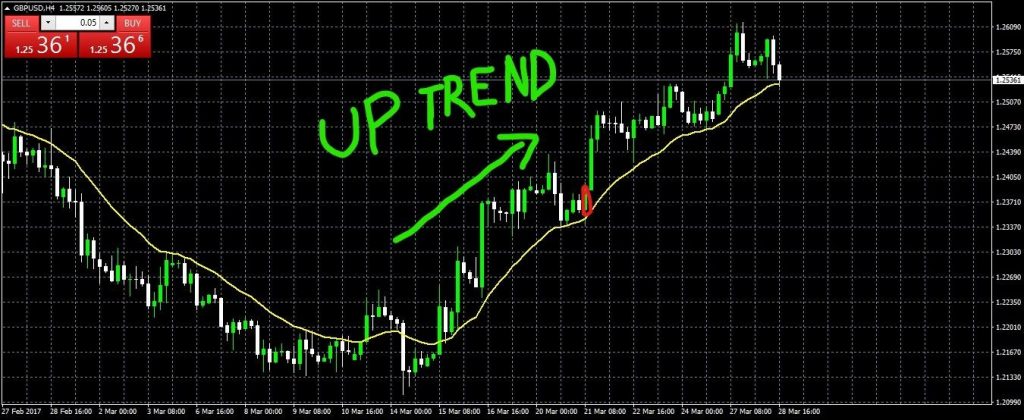
As you can see in this 4H chart for the GBP/USD, an overall uptrend or Bullish trend was identified. Since we identified the bullish trend on this chart, we switch to the shorter time frames to determine where we will try to identify an entry point on the 15 minute time frame.
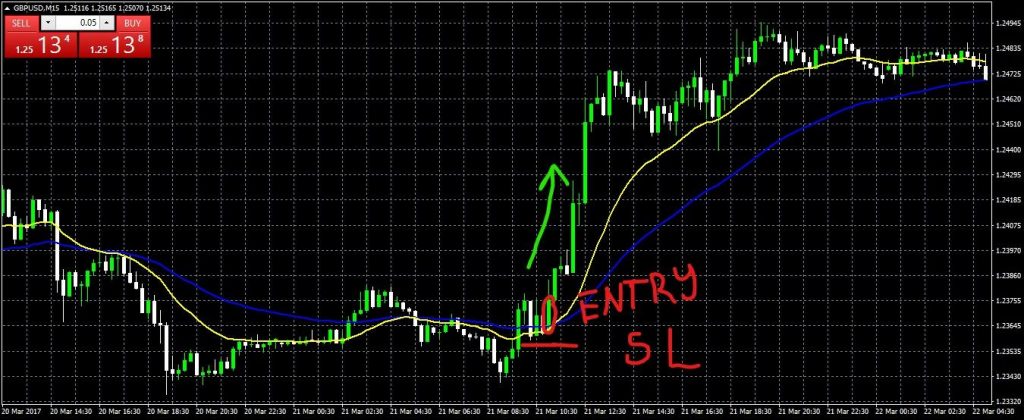
The candle identified by the red circle on both charts indicates an entry point. If you were to use this entry, then it would be wise to place the stop loss below the low of the entry, shown by the red line. Trades conducted on the shorter time frames like this 15 min chart are prone to directional changes, even if the overall trend on the longer time frames do not change. So it would be wise to close out the trade at the first sign of exhaustion. Then you may re-enter at another point.
Counter-Trading the Trend
This is essentially the opposite of trading the trend, even though the steps are similar. When a forex trader decides to counter trade the trend, then the first step that he must make is to identify the overall trend. Like with the ‘trading the trend’ strategy, the best way to do this is to look at the longer time frames. Unlike with trend trading, with counter trading, you are looking for trades that are in the opposite direction of the trend.
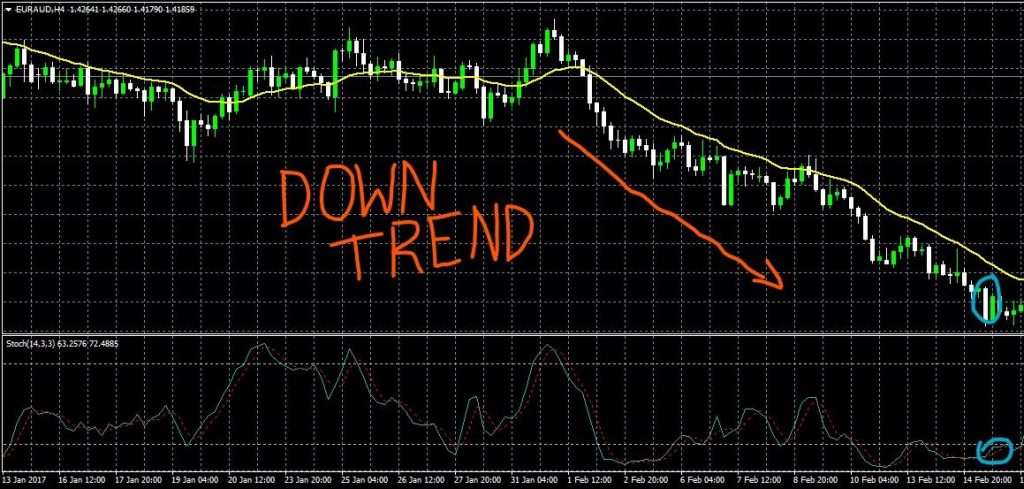
As you can see on this 4H EUR/AUD chart, there is a nice down trend. The area circled in blue, shows a strong bearish candle, followed by a strong bullish candle which at the bottom of a trend could be seen as the trend becoming exhausted. We check our stochastic indicator to be sure, and we see that it is indicating that this is an oversold area (also circled in blue). This could be a good opportunity to use the counter-trend strategy. We now go to check the shorter time frames for an entry point.

If we switch to the 15 min chart, we can see the same oversold area circled in blue, after which price goes down for a bit, but we see a strong bullish candle crossing upwards. This is our entry point. If we timed it properly, we should see some strong upward movement in our direction.
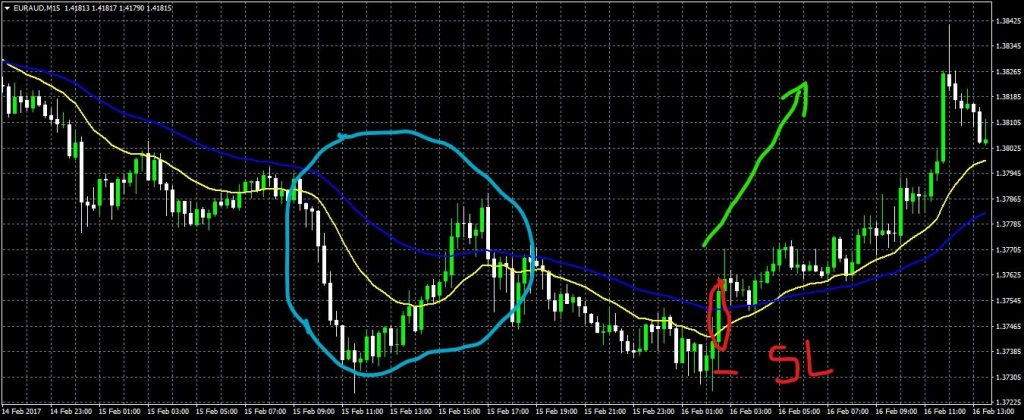
As we can observe, the pair showed a strong upward movement after the entry point on the 15 Minute chart, indicated by the green arrow.
Trading The BreakOut
Perhaps one of the most profitable ways of trading, catching a proper breakout is what many day traders dream of. If done the right way it is an excellent way to make a profit. The breakout is the sudden strong movement of a currency pair in one particular direction after it has formed a range. The tighter the range formed, the stronger the break out will be. Many traders use price orders as a way to catch expected breakouts whenever they see a range formation. They would place a buy order above the range, and a sell order below the range.
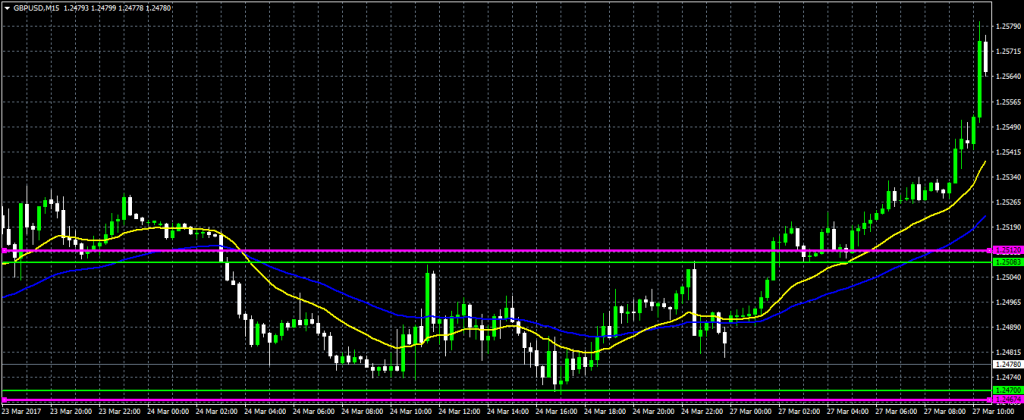
For this 15 min GBP/USD chart, we saw a range formation that is shown by the two green lines. The two magenta lines above and below them would be the two price orders that you would have put on them to catch the breakout. The upper line would have been a buy order, and the lower line would have been a sell order. As you can see the buy order would have been the one triggered, and the strong movement afterward would have provided a nice profit. In calculating profits in a breakout setting, the rule is to set your take profit level at a place where it has the same amount of pips that make up your range.
Considerations: The Guide to Profitable Forex Day Trading
Now that you are aware of the three ways to day trade forex and how each of them works, there are further things for you to consider when deciding to become a forex day trader. You may want to think of this as a kind of guide to profitable forex day trading. There are essentially four rules to keep in mind.
- Choose your time of day carefully:
When it comes to day trading an essential tool that a trader has is market volatility. If you are caught trading on the low volatility times, then it is most likely that you won’t see much pip movement. This means minimal profit if any. It also means waiting long hours before you can close out your trades. The best times to day trade Forex are during the times when more than one market session is in operation. For traders who mainly trade the Euro and the US dollar, this means operating in the hours when the New York session and the London session are both open.
Session |
Open |
Close |
| New York | 8:00 A.M | 5:00 P.M |
| Sydney | 6:00 P.M. | 3:00 A.M. |
| Tokyo | 7:00 P.M. | 4:00 A. M. |
| London | 3:00 A.M | 12:00 P.M. |
- Choose your trading pairs carefully:
The best forex pairs for day trading are those that line up with the time of day that you have chosen to trade. For a person trading the Tokyo session it would not make much sense to be trading the EUR/USD because the New York session closed from 5:00 P.M. and will not open again until the Tokyo session has closed. And the London session would not open until only an hour before the Tokyo session closes. If you were trading the Tokyo session it would be best to trade Asian and Aussie cross pairs because both sessions crossover at 7:00 P.M. (They would both be open at that time). It would be best to trade pairs like the AUD/JPY.
- Keep track of important news
Any Forex day trader worth his salt knows that certain news events have the potential to turn the market upside down. It is therefore essential that a Forex day trader is aware of any major news events scheduled for the day, so that he may take caution with his trading. During certain news events it is even recommended for traders to avoid the currency pairs that will be affected. This will reduce the chances of being caught in a potentially deadly currency spike or fall, like the infamous CHF tsunami, when the price dropped 2,000+ pips in the space of minutes. Many traders lost their accounts that day.
- Be disciplined with your trading strategy
Any profitable forex strategy cannot make money by itself. Even the best, most simple ones, need a trader who has the discipline to stick to the rules that make up the strategy. If a trader does not have the discipline, and the right mindset to his trading, then it is most likely that he will fail, regardless if he uses the best strategies.
If you follow these four rules, coupled with the right day trading strategy, a good risk:reward ratio and the right amount of discipline, you will surely become consistently profitable trader.













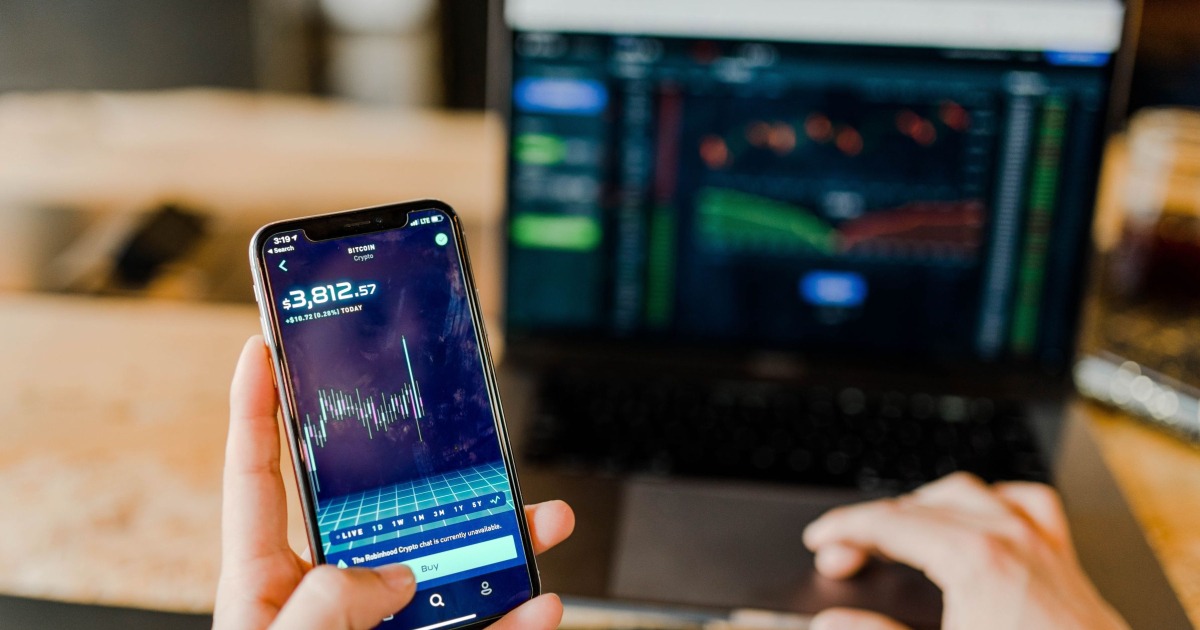












Comments (0 comment(s))